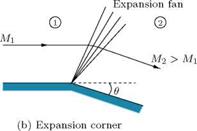Oblique Shock and Expansion Waves
The normal shock wave, a compression front normal to the flow direction. However, in a wide variety of physical situations, a compression wave inclined at an angle to the flow occurs. Such a wave is called an oblique shock. Indeed, all naturally occurring shocks in external flows are oblique.
In steady subsonic flows, we generally do not think in terms of wave motion. It is usually much simpler to view the motion from a frame of reference in which the body is stationary and the fluid flows over it. If the relative speed is supersonic, the disturbance waves cannot propagate ahead of the immediate vicinity of the body and the wave system travels with the body. Thus, in the reference frame in which the body is stationary, the wave system is also stationary; then the correspondence between the wave system and the flow field is direct.
The normal shock wave is a special case of oblique shock waves, with shock angle в = 90°. Also, it can be shown that superposition of a uniform velocity, which is normal to the upstream flow, on the flow field of the normal shock will result in a flow field through an oblique shock wave. This phenomenon will be employed later in this section to get the oblique shock relations. Oblique shocks are usually generated when a supersonic flow is turned into itself. The opposite of this, that is, when a supersonic flow is turned away from itself, results in the formation of an expansion fan. These two families of waves play a dominant role in all flow fields involving supersonic velocities. Typical flows with oblique shock and expansion fan are illustrated in Figure 9.24.
In Figure 9.24(a), the flow is deflected into itself by the oblique shock formed at the compression corner, to become parallel to the solid wall downstream of the corner. All the streamlines are deflected to the same angle в at the shock, resulting in uniform parallel flow downstream of shock. The angle в is referred to as Bow deflection angle. Across the shock wave, the Mach number decreases and the pressure, density and temperature increase. The corner which turns the flow into itself is called compression or concave corner. In contrast, in an expansion or convex corner, the flow is turned away from itself through
 |
 |
Figure 9.24 Supersonic flow over compression and expansion corners.
an expansion fan, as illustrated in Figure 9.24(b). All the streamlines are deflected to the same angle в after the expansion fan, resulting in uniform parallel flow downstream of the fan. Across the expansion wave, the Mach number increases and the pressure, density and temperature decrease. From Figure 9.24, it is seen that the flow turns suddenly across the shock and the turning is gradual across the expansion fan and hence all flow properties through the expansion fan change smoothly, with the exception of the wall streamline which changes suddenly.
Oblique shock and expansion waves prevail in two – and three-dimensional supersonic flows, in contrast to normal shock waves, which are one-dimensional. In this chapter, we shall focus our attention only on steady, two-dimensional (plane) supersonic flows.











